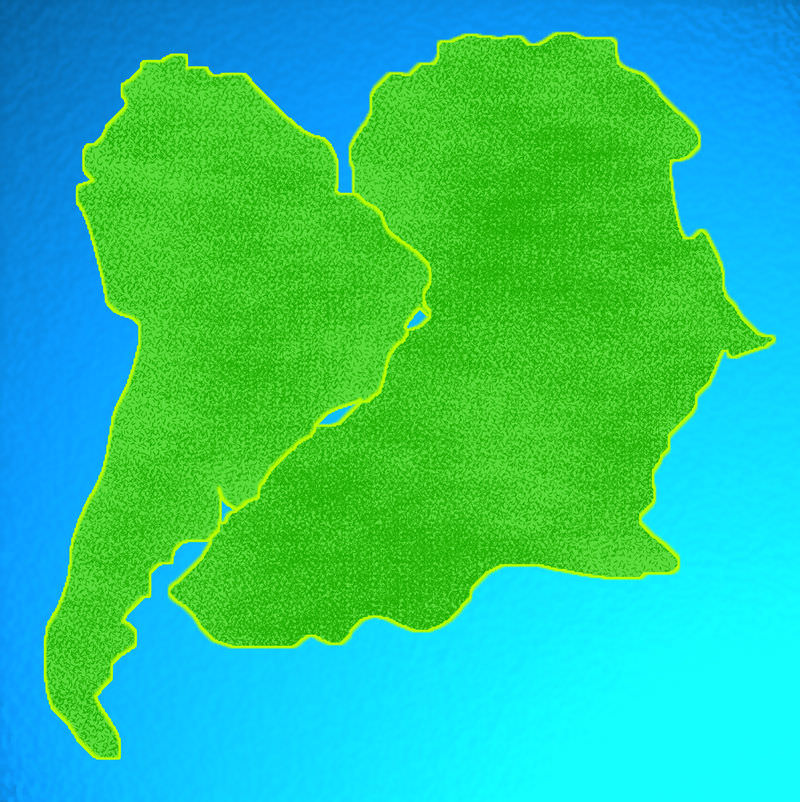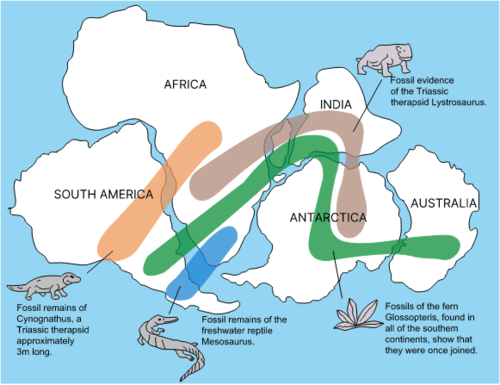5.1大陆漂移
章节大纲
-
What does a scientist do with an interesting observation?
::科学家用有趣的观察做什么?Alfred Wegener made an observation. From that observation, he made a hypothesis . He collected evidence that would support or refute his hypothesis. What did that process look like?
::Alfred Wegener发表了看法,他从这一看法中得出了一个假设。他收集了证据,支持或驳斥他的假设。这一过程是什么样子的?Wegener’s Idea
::Wegener 的创意Alfred Wegener , born in 1880, was a meteorologist and explorer. In 1910, he noticed that South America and Africa appeared to fit together like puzzle pieces. He was certainly not the first person to notice this. But he was intrigued by the idea and thought a lot about it. He wondered if the two continents were once joined and then moved apart? He set out to find evidence to support or refute this idea.
::阿尔弗雷德·韦格纳(Alfred Wegener)生于1880年,是一名气象学家和探险家。1910年,他注意到南美洲和非洲似乎像拼图片一样融为一体。他肯定不是第一个注意到这一点的人。但他对这个想法很感兴趣,并深思熟虑。他想知道这两个大陆是否曾经合并,然后又分开了?他开始寻找支持或驳斥这个想法的证据。Wegener’s Evidence
::韦格纳的证据Wegener and his supporters collected several pieces of geological and fossil evidence for his continental drift hypothesis.
::Wegener及其支持者收集了若干地质和化石证据,以证明他的大陆漂移假设。Fit of the Continents
::各大洲的适合性The continents appear to fit together, and not just South America and Africa. If the are included, the fit is even better.
::不仅南美和非洲,而且这些大陆似乎相互融合。 如果包括这些大陆,那么它们就更好了。This figure shows the evolution of the continents, from the super-continent Pangaea to the way they look now. Distribution of Fossils
::化石的分发Wegener found fossil evidence that the continents were once joined ( Figure ). The same type of plant and animal fossils are found on continents that are now widely separated. These organisms would not have been able to travel across the oceans. So how did the fossils get so far apart?
::韦格纳发现有化石证据表明大陆曾经合并(图 ) 。 同样的植物和动物化石也出现在现在被广泛分离的大陆上。 这些生物不可能跨过海洋。 那么这些化石是如何分裂的呢?Fossils of the seed fern Glossopteris are found across all of the southern continents. These seeds are too heavy to be carried across the ocean by wind . Mesosaurus fossils are found in South America and South Africa. Mesosaurus could swim, but only in shallow water . Cynognathus and Lystrosaurus were early ancestors of mammals that lived on land. Both of these animals were unable to swim at all. Their fossils have been found across South America, Africa, India, and Antarctica.
::南方各大洲都发现了Glossopteris种子的果实,这些种子太重,无法通过风穿过海洋。在南美洲和南非发现了中龙化石。中龙可以游泳,但只能在浅水中游泳。青藤和流星龙是居住在陆地上的哺乳动物的早期祖先。这两种动物根本无法游泳。它们的化石遍布南美洲、非洲、印度和南极洲。Wegener thought that all of these organisms must have lived side by side. The lands later moved apart so that the fossils are separated.
::Wegener认为,所有这些生物必须并肩生存。 土地后来被拆散,以隔离化石。Wegener used fossil evidence to support his continental drift hypothesis. The fossils of these organisms are found on lands that are now far apart. Wegener suggested that when the organisms were alive, the lands were joined and the organisms were living side-by-side. Distribution of Rocks and Structures
::岩石和结构分布Wegener found of the same type and age on both sides of the Atlantic Ocean. He thought that it could not be a coincidence! He said that the rocks must have formed side by side. These rocks then drifted apart on separate continents.
::韦格纳在大西洋两岸都发现了同样的类型和年龄,他认为这不可能是巧合。他说岩石必须同时形成。然后这些岩石漂移在不同的大陆上。Wegener also matched up mountain ranges across the Atlantic Ocean. The Appalachian Mountains were just like mountain ranges in eastern Greenland, Ireland, Great Britain, and Norway. Wegener concluded that they formed as a single mountain range. This mountain range broke apart as the continents split up. The mountain range separated as the continents drifted.
::维格纳(Wegener)也与大西洋的山脉相匹配。阿巴拉契亚山脉与东格陵兰、爱尔兰、英国和挪威的山脉相似。维格纳(Wegener)得出结论,它们形成为单一的山脉。随着各大洲的分裂,山脉分裂了。随着大陆的漂移,山脉分裂了。Climate Zones
::气候区Climate is found in zones around the planet . Warm tropical climates are mostly found near the equator . are mostly found nearer the poles. Wegener assumed that these things were true in the ancient past.
::气候存在于地球周围的地带。温暖的热带气候大多在赤道附近发现,大多在北极附近发现。韦格纳认为这些事在古老的过去是真实的。Glaciers
::冰川Wegener looked at evidence from ancient glaciers. Glaciers are found in very cold climates near the poles. The evidence left by some ancient glaciers is very close to the equator. Did glaciers once exist near the equator? Wegener knew that this was extremely unlikely! However, if the continents had moved, the glaciers would have been centered close to the South Pole.
::Wegener 查看了古代冰川的证据。 冰川是在极地附近的非常寒冷的气候中发现的。 一些古代冰川留下的证据非常接近赤道。 冰川曾经存在过赤道附近吗? Wegener知道这极不可能! 但是, 如果大陆移动了, 冰川会集中在南极附近 。Tropics
::热带Coral reefs are found only in warm water. Coal swamps are also found in tropical and subtropical environments. Wegener discovered ancient coal seams and coral reef fossils in areas that are much too cold today. Wegener thought that ancient coral and coal swamps existed at about the same where they are found today. He again stated that it was the continents that moved.
::珊瑚礁只见于温暖的水中,煤炭沼泽也见于热带和亚热带环境中。 Wegener在今天太冷的地区发现了古老的煤矿接缝和珊瑚礁化石。Wegener认为,古珊瑚和煤炭沼泽的存在与今天大致相同。他再次指出,是大陆在移动。Summary
::摘要- Alfred Wegener made an observation. Africa and South America appeared to fit together like puzzle pieces.
::阿尔弗雷德·韦格纳做了观察。非洲和南美洲似乎像拼图一样融为一体。
- Wegener then asked an important question and set about to answer it. Were the continents once joined and then they drifted apart?
::韦格纳接着问了一个重要问题,并准备回答。 大陆曾经合并过,然后又四分五裂吗?
- Wegener collected a great deal of evidence to support his idea. Wegener’s evidence included the fit of the continents, the distribution of ancient fossils, the placement of similar rocks and structures on the opposite sides of oceans, and indicators of ancient climate found in locations where those climates do not exist today.
::韦格纳收集了大量证据来支持他的想法。 韦格纳的证据包括大陆的适合性、古老化石的分布、类似岩石和结构在海洋对面的分布、以及今天不存在这些气候的地方的古老气候指标。
Review
::回顾- What was the scientific question that Wegener asked?
::韦格纳问的科学问题是什么?
- What did he need to do to explore the question and make it into a hypothesis?
::他需要做些什么来探究这个问题并将其变成假设?
- What evidence did Wegener have to support his idea?
::韦格纳有什么证据支持他的想法?
- Describe how Wegener used each type of evidence to support his idea.
::描述韦格纳如何使用各种证据来支持他的想法。
Explore More
::探索更多Use the resources below to answer the questions that follow.
::利用以下资源回答以下问题。- Who was Alfred Wegener?
::谁是阿尔弗雷德·韦格纳?
- What evidence did Wegener find for Pangaea?
::韦格纳为潘加亚找到了什么证据?
- What was the response to Wegener's hypothesis?
::韦格纳的假设有什么反应?
- What is the continental drift hypothesis?
::大陆漂流假设是什么?
- What do the continental plates consist of?
::大陆板由什么组成?
- What were formed when Pangaea broke apart?
::潘盖亚分裂时形成什么?
- Is the word "theory" misused in these two videos? What is the better word?
::这两个视频中"理论"这个词是不是被滥用了?
- Alfred Wegener made an observation. Africa and South America appeared to fit together like puzzle pieces.


